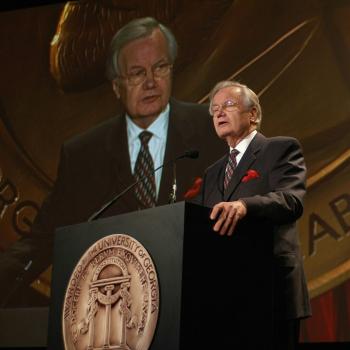
What Modern Culture, History & the Bible Reveal about God’s Messengers
While angels come in all shapes, sizes and temperaments in popular culture, many take the form of humans. Down through history, we have had everything from beautifully painted angels by Renaissance masters to cute cherubs on greeting cards. But what does the Bible say? Are angels real? Or are they simply literary images that biblical writers used to make a point?
The Bible has quite a bit to say about angels. The number of references to them depends on which translation or version of the Bible you read, but it’s safe to say that the Old and New Testaments mention them several hundred times.
Some biblical angels deliver good news, as in the announcement of Christ’s birth to shepherds in the fields. Others are quite terrifying. Many Christians believe in these messengers from God, while others don’t. Atheists and agnostics no doubt reject them, but I’m a firm believer.
So, let’s sit back and take a look at angels in popular culture, history and the Bible.
Angels in Popular Culture
In modern times, movies have shown God’s messengers as human-like beings, and many of them portray angels helping downtrodden humans.
One of the world’s first-ever movies is The Christmas Angel, a short from 1904. It concerns a poverty-stricken girl who begs for food for her bedridden mother but is thwarted by professional beggars.
The movie is set in Paris and has two endings. The American version shows two human angels rescuing the girl, while the French version has the Christmas Angel carrying the girl to heaven. Learn more about The Christmas Angel or watch clips here.
Jumping ahead, films about angels were popular in the 1930s and 1940s when people were struggling through the Great Depression and World War II.
The 1940s saw a benevolent angel in the form of an elderly man in a nightshirt named Clarence Odbody, who shows Jimmy Stewart’s despondent George Bailey how life in his small town would have been without him. The movie, of course, is the Christmas classic It’s a Wonderful Life. Everyone should see it at least once.
Cary Grant’s suave angel in The Bishop’s Wife from 1947 is quite different, but his mission is similar. In the film, Grant’s character provides spiritual guidance to a dejected bishop played by David Niven. Loretta Young stars as the bishop’s wife.
It seems the bishop wants to build a cathedral and prays for guidance. Dudley, Grant’s character, immediately appears. “It’s a sweet, funny, captivating, altogether delightful picture….” said one reviewer in the UK’s Daily Mail. Other reviewers were less kind, but with Cary Grant in the lead, it might be worth watching. Learn more about it here.
Angels in the Outfield (1951 and 1994) gives us yet another look at angels in popular culture. The two versions have slightly different plots, but basically tell the story of a down-and-out major baseball team that gets help from an angel with baseball smarts.
In the remake, a little boy asks his widowed father when they will be a family again, and the father sarcastically says, “When the Angels win the pennant.” The Angels are terrible, and the little boy turns to prayer.
Shortly afterward, he attends a game and sees a team of angels led by head angel Christopher Lloyd helping the human players. The boy, by the way, is the only person who sees the heavenly helpers. Read a detailed synopsis of the movie here.
Popular culture also has given us City of Angels starring Nicholas Cage as an angel who falls in love and decides to become mortal.
Then, there’s John Travolta who says he’s an angel in Michael, though he drinks, smokes and enjoys women. He’s scruffy and boorish, but has wings. Go figure. And then, Cameron Diaz and Ewan McGregor star in A Life Less Ordinary about match-making angels sent to earth.
The list of movies about angels goes on and on.
Angels in History
Three out of four American adults – some 200 million people – said they believe in angels in recent surveys. They are influenced by popular culture, angels in history and angels in religions including Christianity, Judaism, Islam and Hindu.
The earliest Christian image of an angel was painted in the mid-third century. Located in the Catacombs of Priscilla in Rome, the simple scene shows a man and a woman with the angel Gabriel.
The man, who wears a tunic, stands facing the woman, who is seated. In this first painting of an angel, Gabriel is shown without wings. (Artists didn’t begin to add them until the fourth century.)
While the people depicted in these frescos look rather flat, the 15th century Spanish artist Bermejo depicted the Archangel Michael in beautiful and stunning detail.
In Saint Michael Triumphs over the Devil, an impossibly slender Michael, clad in a golden suit of armor, towers over and calmly defeats Satan. (The painting hangs in the National Gallery in London, and you can see it here.)
And we cannot forget the angels that masters such as Michelangelo, da Vinci and Rafael famously painted during the Renaissance. Their paintings have amazed and delighted art lovers for centuries.
Angels in the Bible
Are angels real? The Bible says a great deal about angels, such as…
- Angels are messengers from God.
- God created angels before he created the universe.
- They are not human.
- Angels are a little higher than us.
- God forbids angel worship.
- Angels are powerful and wise beings, but don’t know everything.
- They are spiritual beings that don’t have physical bodies, though they sometimes appear and interact with people.
- They do not marry, nor do they die.
The Bible doesn’t specifically say that Satan was once an angel, but Christian tradition tells us that he was until he rebelled. God then cast him out of heaven and about a third of the angels went with him, according to Local Histories, an online history encyclopedia.
Are Angels Real?
The Bible says they are, and it describes four types of angels:
- Cherubim
- Seraphim
- Archangels
- Fallen angels
The biblical descriptions are far removed from chubby cherubim shown on greeting cards or debonair angels of popular culture.
The Bible tells us cherubim have four faces, four wings and four appendages that look like human hands under their wings. Their four faces – as described in the book of Ezekiel – are those of an eagle, a human, an ox and a lion, and their feet are the hooves of a bull. Click here and scroll down to see a truly frightening representation of one.
God used these angels to guard the Garden of Eden when he expelled Adam and Eve, and they also appear numerous other times in the Old and New Testaments.
The word seraphim means burning or fiery ones, and the Bible mentions them in the book of Isaiah. Isaiah 6:2-3 recounts the prophet seeing seraphim as they fly above God, who is seated on his throne.
They have six wings and are typically painted in blue, which represents the sky. Two wings cover their faces, two cover their feet and two are used for flying.
Archangel means chief angel. Michael is the only archangel that the Bible specifically names, although many Christians believe that Gabriel is an archangel as well.
Revelation tells us that war breaks out in heaven, and Michael and his angels fight a dragon. Michael also helps Daniel in the Old Testament. Gabriel, on the other hand, appears as a messenger angel in Luke 1:19 and 26, and he gives Daniel insight in Daniel 9:21-22.
The fallen angels are Satan and his demons. Enough said.
Read more about angels by clicking here. You also may read more about angels in the following biblical verses:
- Lot encounters two angels, who appeared as humans, in Sodom (Genesis 19)
- An angel protects Daniel in the lion’s den (Daniel 6:22-23)
- The angel Gabriel appears to the virgin Mary (Luke 1:26-38)
- Angels provide for Jesus in the wilderness (Matthew 4:11)
- An angel gives Christ strength in Gethsemane (Luke 22:43)
These examples show benevolent angels, but keep in mind that angels can bring judgment, as they did in destroying the Assyrian army in 2 Kings 19:35 and unleashing God’s judgment on humankind in Revelation.
So, Are Angels Real?
Patheos contributor Gregory Smith believes they are. In his blog post, Do You Believe in Angels? he recounts a frightening experience his family had with his young daughter’s invisible “friend.”
Having such a friend isn’t unusual for young children, but Smith came to the realization that his daughter’s “friend” actually existed and was a demon. I won’t share the ending, except to say it involves angels. Read it here.
Angels are real to me, as well. My story is less dramatic than Smith’s, but it was a turning point in my life.
Like Smith’s story, mine involves one of my daughters. She was a teenager and running wild at the time. I thought she was acting out as teens do — until the point her behavior became life-threatening. (She was later diagnosed with schizoaffective disorder, which I think of as bipolar disorder on steroids.)
I had lost complete control of my younger daughter by the time she turned 17. Each time she walked out the door, I prayed that she would return home in one piece… that I wouldn’t receive the phone call from police that parents of teens dread.
My days and nights were filled with prayers. I prayed and prayed and prayed some more. Knowing that I was powerless to protect my daughter, I asked God to give her a guardian angel. In fact, I prayed for both daughters to have an angel.
God answered me one evening when I was playing piano for children’s choir practice. Choir practices are start-and-stop affairs for the pianist – play a while and stop for the director to talk to the choir a while, then play again.
I had stopped playing for a few minutes, and as I sat quietly on the piano bench, the sanctuary became very still. I no longer heard the choir director speaking to the choir. Instead, a very clear voice spoke to me: “She will be alright,” it said.
The voice was neither male nor female, but it was so real that I turned toward the sound. There was no one there, and the choir was oblivious to it. But the voice was as real as any voice I had ever heard, and no, I wasn’t hallucinating. It was the first and only time I had ever had such and experience.
“She will be alright.” These simple words brought me a great feeling of peace. Soon afterward, with the help of God and an excellent psychiatrist, my daughter took the first steps toward controlling the disease that nearly destroyed both of us.
Are angels real? You bet they are!














